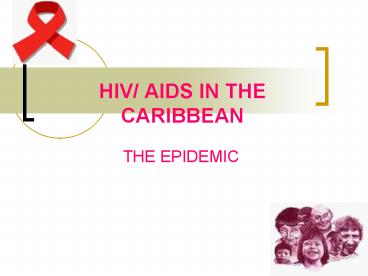HIV AIDS IN THE CARIBBEAN - PowerPoint PPT Presentation
1 / 20
Title:
HIV AIDS IN THE CARIBBEAN
Description:
The AIDS epidemic is arguably the most devastating threat to the health of mankind. ... The Beach Boys (in Barbados) and Janki Panki (in the Dominican Republic) and ... – PowerPoint PPT presentation
Number of Views:44
Avg rating:3.0/5.0
Title: HIV AIDS IN THE CARIBBEAN
1
HIV/ AIDS IN THE CARIBBEAN
- THE EPIDEMIC
2
Introduction
- The AIDS epidemic is arguably the most
devastating threat to the health of mankind. - It is currently a global threat, impacting every
aspect of our society individuals, families,
communities the wider society.
3
The Medical Perspective
- AIDS (acquired immunodeficiency syndrome) is
caused from infection of the HIV (human
immunodeficiency virus). - The virus is transmitted through
- Unprotected sexual intercourse
- Blood transfusion
- Organ or tissue transplants
- Use of contaminated needles
- Mother to child transmission
4
- The virus does not survive for very long once
outside body fluids and tissues. It cannot
penetrate unbroken skin. - Symptoms of infection are usually not seen until
about months after infection. A common initial
sign is the HIV flu sore throat, rash, fatigue,
swollen nodes. - As HIV progresses, the number of these T-helper
cells fall, resulting in a loss of ability to
fight off infections
5
- Though traditionally a gay virus, the disease
is now more commonly transmitted through
heterosexual activities. - As a result the gap between male and female case
infections is gradually narrowing. - HIV is more easily passed from males to females
due to the increased area of exposure. It is
predicted that there will be a steady increase of
female infections in the future.
6
Main Risk Factors
- Multiple sex partners
- History of STDs
- Crack/ cocaine use
- Commercial sex
7
High Risk Groups
- Persons with multiple sex partner (concurrent or
serial) - Men who have sex with men (MSM)
- Sex workers
- Drug abusers
- Sexual partners of any of the above
8
The Social Perspective
- Does HIV/ AIDS have a social face?
- HIV/ AIDS is no longer a medical issue with focus
solely on the individual. It is now - Cultural religious taboos
- Behavioural
- Gender inequality
- Equally potent to the affected as the infected
9
Migration as a Risk Factor?
- First reported Caribbean AIDS cases in Haiti,
Jamaica, Trinidad Tobago were among gay men who
had had sex with North American gay men in North
America or in the Caribbean (CAREC).
10
AIDS IN THE CARIBBEAN DIASPORA THE NEW YORK CITY
CASE SCENARIO
- AIDS IN NEW YORK CITY IMMIGRANTS 2000-
DISTRIBUTION BY REGION OF ORIGIN - CARIBBEAN 46
- LATIN AMERICA 27
- E.EUROPE/SOVIET 17
- FAR/NEAR EAST 5
- AFRICA 3
- OTHER 2
- Source Office of AIDS Surveillance NYC
Department of Health. March 2000
Source CAREC Twenty Years of the HIV/AIDS
Epidemic in the Caribbean
11
Tourism as a Risk Factor?
- Tourism dependent countries such as Jamaica,
Bahamas, Barbados Bermuda are the most affected
by the epidemic. - The Beach Boys (in Barbados) and Janki Panki (in
the Dominican Republic) and Rent a Dread are
some of the male sex work and trade to women and
men that contribute to the spread of the disease.
12
The Statistics
- 90 of HIV/ AIDS cases are in developing
countries. - Sub-Saharan Africa has the highest rate of HIV
infection globally - The Caribbean follows as the region with the
second highest HIV prevalence rates (1.6) in the
world. - There were 330,000 PLWA at the end of 2005.
Approx. 22,000 were children lt15yrs
13
HIV Prevalence Rates in the Caribbean (2005)
Source UNAIDS
14
Age Group Distribution of Reported AIDS Cases in
CMCs 1982-2000
Source CAREC Twenty Years of the HIV/AIDS
Epidemic in the Caribbean
15
Categories of Transmission in Reported AIDS Cases
in CMC 1982 - 2000
Source CAREC Twenty Years of the HIV/AIDS
Epidemic in the Caribbean
16
Specific Country Focus Haiti
- In July 1982, the US labelled Haitian migrants to
be carriers of the disease. - Haitians represented 4.5 of the AIDS cases
emerging at that time. - The presumed causal relationship between race and
the disease led the US to list Haitians amongst
the high risk group in the 4H disease
(homosexuals, heroin addicts, hemophiliacs and
Haitians).
17
- The US was never considered the origin of the
disease. - The misguided stigma attached to Haiti did not
change until the US attention was shifted to
Central Africa (mid-1980s). A new scapegoat was
born. - Even then the US presumed Haiti to be a
contributing factor in the spread of the disease
in the African region.
18
- Today, Haiti maintains the highest prevalence
rates in the Caribbean. - There has been a persistent increase in the
percentage of females being infected with HIV. - 79 82 15
- 83 85 27
- 86 88 31
- 91 92 46 Pape in Howe and Cobley, 2000
- An immediate consequence is a simultaneous
progressive increase in the number of children
infected with HIV.
19
Specific Country Focus Cuba
- Why has Cuba maintained a relatively low adult
HIV prevalence rate? - One of the worlds most effective preventative
mother-to-child transmission of HIV programmes - Cuba offers free, universal access to
antiretroviral therapy, limiting the number of
AIDS deaths.
20
Myths
- HIV is the same as AIDS
- You can get HIV from using an infected persons
utensils. - AIDS is a disease that affects only homosexuals
and sex workers. - You can get infected with HIV from mosquito
bites. - HIV persons cannot have children
- HIV cannot be transmitted through oral sex
- There is now a cure for HIV































